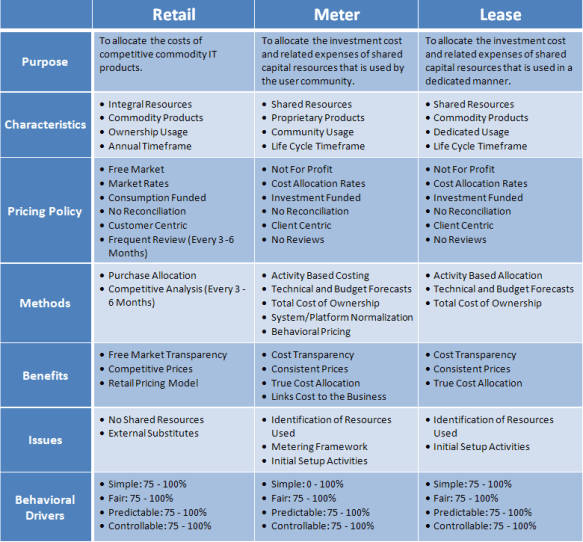Evolution From Recovery
Early Service Catalog
implementations were used
to “recover” annual
operational budgets of the
IT group. These recovery
methods were often very
detailed and were based
on tax code considerations
that did not reflect true
business situations. The
net result was that cost
allocations were often
neither fair nor accurate.
Cloud Computing
While there is no single
definition of Cloud
Computing, most consider
it as a retail based
environment where users
“buy” resources from a
particular vendor. From the
consumer side this is a
true characterization, but
from the vendor side, it is
a matter of temporarily
“leasing” shared resources
that are used for the cloud
processing. These differing
perspectives confuse
Service Catalog
development for the cloud.
Multiple Methods
A modern IT shop provides
a broad set of services
usually based on a shared
set of resources. This
simple fact makes it
difficult to use a single
approach for building a
Service Catalog. To allow
for the scope and flexibility
that is needed in today’s
Service Catalog; there
must be several different
methods available for
Service Catalog
development.
Retail Method
The Retail Method is used to allocate the annual cost of competing commodity IT products. This
method is based on the Amazon Retail model, and is the single most used method for catalog
development. It can be thought of as single purchase items such as an operating system, desk top
system, or other standalone purchases.
Almost all the costing vendors use the Retail Method for their processing, and they do so based on
the standard business data found in General Ledger or other corporate systems. This process is very
business intrusive and does not handle shared IT resources due to the lack of supporting business
data. For many businesses, the shared costs are significantly larger than the commodity costs and
the resulting process leaves a large gap in the Service Catalog.
Meter Method
The Meter Method is used to allocate the investment cost and total associated expense of shared
capital resources that is used by multiple consumers. RG Solutions® does this allocation using a
metering framework that is based on performance information and allows for the allocation of usage
(and thus cost) to the appropriate consumers.
This method can be thought of as the same process that is used by an electric company. In this
process, the usage is measured at various times of the day and charges are based on the dynamic
behavior of the consumer. The consumer is responsible for their behavior and therefore is
responsible for their costs.
Lease Method
The Lease Method is similar to the Meter Method but deals with the dedicated use of shared IT
resources. In this case, the allocation of costs are done in a more static manner and do not require
performance information to determine the cost allocations to the consumers. RG Solutions® supports
this type of cost allocation by merging inputs from other data sources with the internal cost data.
This method can be thought of as the same process used by a car leasing company. In this
process, the product is “leased” for a fixed period of time. As part of the lease agreement, the
consumer is restricted in the use of the product otherwise penalties will apply. A good example of this
type of process is a consumer “leasing” a fixed amount of disk storage for their use.


